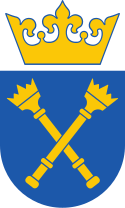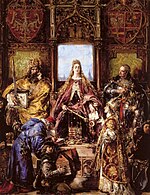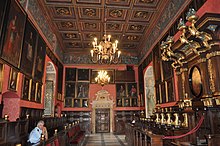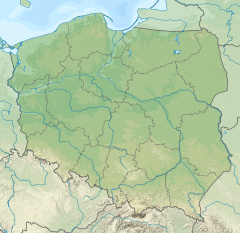
Jagiellonian University
Uniwersytet Jagielloński | |
 | |
| Latin: Universitas Iagellonica Cracoviensis | |
Former names | Studium Generale (1364–1397) Collegium Regium (1397–1400) Collegium Maius (1400–c. late 1500s) Kraków Academy (c. late 1500s–1777) Principal School of the Realm (1777–1795) Principal School of Kraków (1795–1817) |
|---|---|
| Motto | Plus ratio quam vis |
Motto in English | Let reason prevail over force |
| Type | Public |
| Established | 1364 |
| Rector | Jacek Popiel |
Academic staff | 3,942 (2021) |
| Students | 35,517 (2021)[1] |
| Undergraduates | 16,222 (2021)[2] |
| Postgraduates | 11,014 (2021) |
| 2,153 (2021) | |
| Location | , Poland |
| Campus | Urban/college town |
| Affiliations | Coimbra Group EAIE Europaeum EUA Guild of European Research-Intensive Universities IRUN Una Europa Utrecht Network |
| Website | https://en.uj.edu.pl/en |
 | |
The Jagiellonian University (Polish: Uniwersytet Jagielloński, UJ) is a public research university in Kraków, Poland. Founded in 1364 by King Casimir III the Great, it is the oldest university in Poland and the 13th oldest university in continuous operation in the world. It is regarded as Poland's most prestigious academic institution.[3][4] The university has been viewed as a vanguard of Polish culture as well as a significant contributor to the intellectual heritage of Europe.[5]
The campus of the Jagiellonian University is centrally located within the city of Kraków. The university consists of thirteen main faculties, in addition to three faculties composing the Collegium Medicum. It employs roughly 4,000 academics and provides education to more than 35,000 students who study in 166 fields.[5] The main language of instruction is Polish, although around 30 degrees are offered in English and some in German.[6] The university library is among the largest of its kind and houses a number of medieval manuscripts, including the landmark De Revolutionibus by alumnus Nicolaus Copernicus.
In addition to Copernicus, the university's notable alumni include heads of state King John III Sobieski, Pope John Paul II, and Andrzej Duda; Polish prime ministers Beata Szydło and Józef Cyrankiewicz; renowned cultural figures Jan Kochanowski, Stanisław Lem, and Krzysztof Penderecki; and leading intellectuals and researchers such as Hugo Kołłątaj, Bronisław Malinowski, Carl Menger, Leo Sternbach, and Norman Davies. Four Nobel laureates have been affiliated with the university, all in literature: Ivo Andrić and Wisława Szymborska, who studied there, and Czesław Miłosz and Olga Tokarczuk, who taught there.[7] Faculty and graduates of the university have been elected to the Polish Academy of Arts and Sciences, the Royal Society, the British Academy, the American Academy of Arts and Sciences, and other honorary societies.
History[edit]
Founding the university[edit]

In the mid-14th century, King Casimir III the Great realised that the nation needed a class of educated people, especially lawyers, who could arrange a better set of the country's laws and administer the courts and offices. His efforts to found an institution of higher learning in Poland were rewarded when Pope Urban V granted him permission to set up a university in Kraków. A royal charter of foundation was issued on 12 May 1364, and a simultaneous document was issued by the city council granting privileges to the Studium Generale.
Development of the University of Kraków stalled upon the death of Casimir III, and lectures were held in various places across the city, including, amongst others, in professors' houses, churches and in the cathedral school on the Wawel Hill. It is believed that the construction of a building to house the Studium Generale began on Plac Wolnica in what is today the district of Kazimierz.
After a period of low interest and lack of funds, the institution was restored in the 1390s by Jadwiga, queen of Poland, the daughter of Louis the Great. The royal couple, Jadwiga and her husband Władysław II Jagiełło decided that, instead of building new premises for the university, it would be better to buy an existing edifice; it was thus that a building on Żydowska Street, which had previously been the property of the Pęcherz family, was acquired in 1399. The Queen donated all of her personal jewellery to the university, allowing it to enroll 203 students. The faculties of astronomy, law and theology attracted eminent scholars: for example, John Cantius, Stanisław of Skarbimierz, Paweł Włodkowic, Jan of Głogów, and Albert Brudzewski, who from 1491 to 1495 was one of Nicolaus Copernicus' teachers.[8] The university was the first university in Europe to establish independent chairs in Mathematics and Astronomy. This rapid expansion in the university's faculty necessitated the purchase of larger premises in which to house them; it was thus that the building known today as the Collegium Maius, with its quadrangle and beautiful arcade, came into being towards the beginning of the 15th century. The Collegium Maius' qualities, many of which directly contributed to the sheltered, academic atmosphere at the university, became widely respected, helping the university establish its reputation as a place of learning in Central Europe.
Golden age of the Renaissance[edit]

For several centuries, almost the entire intellectual elite of Poland was educated at the university,[citation needed] where they enjoyed particular royal favors. While it was, and largely remains, Polish students who make up the majority of the university's students, it has, over its long history, educated thousands of foreign students from countries such as Lithuania, Russia, Hungary, Bohemia, Germany, and Spain. During the second half of the 15th century, over 40 percent of students came from the outside of the Kingdom of Poland.

The first chancellor of the university was Piotr Wysz, and the first professors were Czechs, Germans and Poles, most of them trained at the Charles University in Prague. By 1520 Greek philology was introduced by Constanzo Claretti and Wenzel von Hirschberg; Hebrew was also taught. At this time, the Collegium Maius consisted of seven reading rooms, six of which were named for the great ancient scholars: Aristotle, Socrates, Plato, Galen, Ptolemy, and Pythagoras. Furthermore, it was during this period that the faculties of Law, Medicine, Theology, and Philosophy were established in their own premises; two of these buildings, the Collegium Iuridicum and Collegium Minus, survive to this day. The golden era of the University of Kraków took place during the Polish Renaissance, between 1500 and 1535, when it was attended by 3,215 students in the first decade of the 16th century, and it was in these years that the foundations for the Jagiellonian Library were set, which allowed for the addition of a library floor to the Collegium Maius. The library's original rooms in which all books were chained to their cases in order to prevent theft are no longer used as such. However, they are still occasionally open to hosting visiting lecturers' talks.




